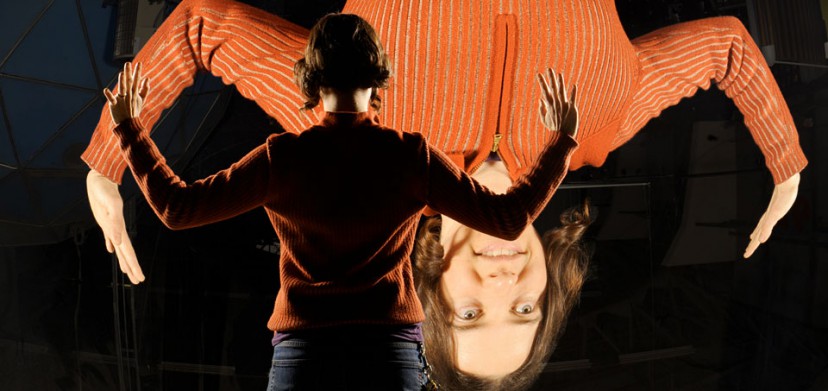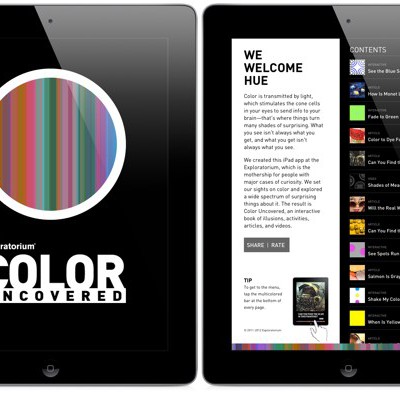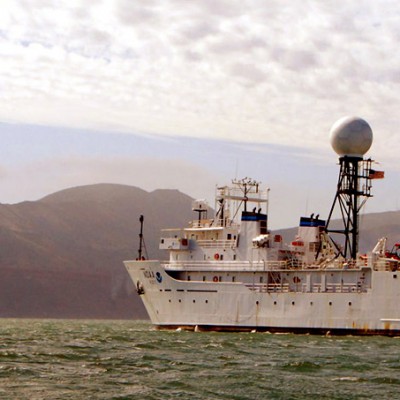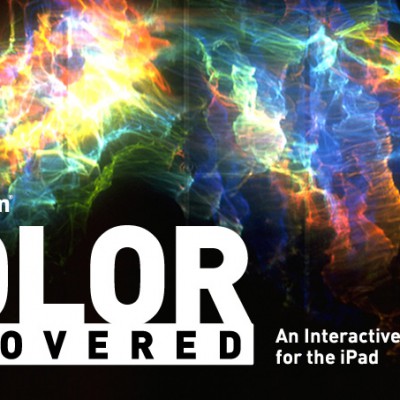
When you enter the Exploratorium on a summer’s afternoon, you’ll find hundreds of children and their adults absorbed in the work of serious play. One family is intently focused on building a freestanding arch from blocks provided, children wearing headphones compare their abilities to differentiate high frequency pitches, and two young girls are conversing via an echo chamber. It’s lively, it’s noisy, and every one is engaged.
When he founded the Exploratorium in 1969, physicist Frank Oppenheimer wanted to transform science education by creating a museum where people could experience and discover how the world works. Today the Exploratorium’s exhibits, tools, and games put the visitor at the center of the learning experience; they rely on our innate curiosity to propel the discovery process and foster the visitor’s own ability as inquirer. Scientists, artists, and educators build these explore-it-yourself exhibits in the museum’s wide-open shop. The exhibits are aesthetically satisfying, ingenious and elegant, drawing on all five senses and igniting visitors’ perceptions intellectually and viscerally. If you sit and watch Exploratorium visitors for even a few minutes, you can witness gleeful and profound “aha!” moments nonstop.
The Exploratorium’s reach extends far beyond the walls of its beautiful new net-zero energy building on Pier 15 on the San Francisco waterfront. By taking an inquiry-based approach into the digital environment, the Exploratorium’s 50,000 web pages, popular apps, and live-science web-casts, expeditions and events have created a strong international following among science teachers, science enthusiasts, artists, and students of all ages. “Our work today is not bound by medium,” says director of the digital experience lab Lowell Robinson. “What is the full learning potential of the digital platform?” asks former Exploratorium director of digital learning, Jean Cheng. “That is our inquiry.”
The museum launched its website in 1993 as one of the first 1,000 websites in existence, and was the second museum in the world to do so. The Exploratorium’s initial digital successes included inside-the-museum projects like interactive exhibits, as well as on-line remote webcasting, user-commenting, and teacher curriculum modules. More than 12 million people visit the website annually and 1.4 million external links point to the Exploratorium’s on-line pages. More than 80 percent of visits are to content vs. bricks-and-mortar museum information. The Exploratorium’s two earliest apps are highly rated and widely used. The first one, Color Uncovered, has been downloaded more than a million times so far. A recent Google Hang-out with the museum’s Tinkering Studio and MIT drew 50,000 participants.
The Exploratorium landed a series of major National Science Foundation grants from 1994 – 2013. Although Exploratorium staff report that future grants are less likely due to shifting priorities at NSF, the grants received so far sparked many of the Exploratorium’s digital education projects. “The sequencing of project grants was sufficient to sustain a core digital staff even though the funding came in on a project basis,” says physicist Rob Semper, Associate Executive Director of Laboratory and Museum, whom staff described as the de facto publisher of everything the Exploratorium created digitally in the past. Because all of the grants focused on program initiatives, teachers and learners had priority for digital projects and infrastructure-building, and these were built before the Exploratorium addressed institutional needs for marketing and visitor services. The Exploratorium’s digital education projects sometimes attract very large audiences, such as the millions of viewers gathered online to watch the Transit of Venus webcast from Mauna Loa, Hawaii.
Analysis has shown that the museum’s spikes in online traffic are episodic and tend to attract niche audiences to specific subject matter. A challenge for the Exploratorium is to sustain digital engagement at a high level and to broaden audience appeal so that a core audience grows over time.
In fiscal 2014, the Exploratorium board and staff created an Online Strategy Subcommittee to develop the next few years’ digital strategy and to determine how aggressive its growth assumptions should be. During 2014 they developed a set of possible goals for online strategy and looked not only at the requirements and outcomes differentiating them, but also what it would take to realize each option. Bain & Company, the Exploratorium’s strategy consultants, researched the Exploratorium’s reach compared to social media platforms like Facebook and LinkedIn, news sources like CNN and Huffington Post, and other museums like the Smithsonian and MOMA. Overall, the Exploratorium’s board, which includes several successful tech entrepreneurs, believes public engagement with the Exploratorium’s digital programs, applications, and experiences can grow significantly. The question the committee is answering? What would it take to engage 10 times as many people?
The new strategy aspires to more than consistently high traffic. It will also answer the question of the Exploratorium’s future business model for digital. With the likelihood of fewer large project grants, new digital revenue sources are needed. Thus far, only a few private donors, including individuals and private foundations, have granted operating and endowment grants for digital. (Most private sector revenue is for physical and educational, not digital, programs.) But the Exploratorium has a large digital footprint, with further growth potential. It seems at least possible that the museum’s revenue mix could change significantly.
Semper says the next stage of the Exploratorium’s digital strategy will likely build on creative new content to expand daily reach – a “go broad” plan, coupled with a “go deep” effort to develop closer ties with educators, science enthusiasts, tinkerers and other niche audiences. The Online Strategy Committee thinks that once the museum develops and sustains a high level of monthly traffic for Exploratorium offerings, more revenue will follow through sponsorships, partnerships, foundation grants, fees-for-service and individual contributions. You’ll want to follow their next steps.
Profile Links:
- Exploratorium at a glance
- Deep Sea Exploration with Bob Ballard and the E/V Nautilus
- Arts at the Exploratorium, The Best Things in Museums are the Windows
- Exploratorium's Global Studios
- Executive Director Chris Flink
- Exploratorium Apps
Grant Funding:
- National Science Foundation for The Science Learning Network
- National Science Foundation for The Exploratorium Institute for Inquiry
- National Science Foundation toward The Accidental Scientist: Internet Resources Exploring Science in Everyday Life
- National Science Foundation toward Professional Development Institutes to Increase Afterschool Educators’ Use of the NSDL (National Science Digital Library)
- National Science Foundation for EAGER: An Indoor Positioning System for Informal Learning Experiences
- Gordon and Betty Moore Foundation



